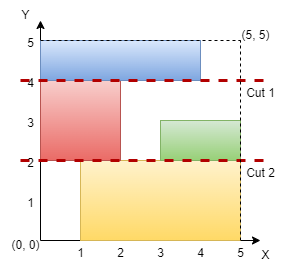3394. 判断网格图能否被切割成块
题目描述
给你一个整数 n 表示一个 n x n 的网格图,坐标原点是这个网格图的左下角。同时给你一个二维坐标数组 rectangles ,其中 rectangles[i] 的格式为 [startx, starty, endx, endy] ,表示网格图中的一个矩形。每个矩形定义如下:
(startx, starty):矩形的左下角。(endx, endy):矩形的右上角。
注意 ,矩形相互之间不会重叠。你的任务是判断是否能找到两条 要么都垂直要么都水平 的 两条切割线 ,满足:
- 切割得到的三个部分分别都 至少 包含一个矩形。
- 每个矩形都 恰好仅 属于一个切割得到的部分。
如果可以得到这样的切割,请你返回 true ,否则返回 false 。
示例 1:
输入:n = 5, rectangles = [[1,0,5,2],[0,2,2,4],[3,2,5,3],[0,4,4,5]]
输出:true
解释:

网格图如上所示,我们可以在 y = 2 和 y = 4 处进行水平切割,所以返回 true 。
示例 2:
输入:n = 4, rectangles = [[0,0,1,1],[2,0,3,4],[0,2,2,3],[3,0,4,3]]
输出:true
解释:

我们可以在 x = 2 和 x = 3 处进行竖直切割,所以返回 true 。
示例 3:
输入:n = 4, rectangles = [[0,2,2,4],[1,0,3,2],[2,2,3,4],[3,0,4,2],[3,2,4,4]]
输出:false
解释:
我们无法进行任何两条水平或者两条竖直切割并且满足题目要求,所以返回 false 。
提示:
3 <= n <= 1093 <= rectangles.length <= 1050 <= rectangles[i][0] < rectangles[i][2] <= n0 <= rectangles[i][1] < rectangles[i][3] <= n- 矩形之间两两不会有重叠。
解法
方法一
Python3
class Solution:
def countLineIntersections(self, coordinates: List[tuple[int, int]]) -> bool:
lines = 0
overlap = 0
for value, marker in coordinates:
if marker == 0:
overlap -= 1
else:
overlap += 1
if overlap == 0:
lines += 1
return lines >= 3
def checkValidCuts(self, n: int, rectangles: List[List[int]]) -> bool:
y_coordinates = []
x_coordinates = []
for rect in rectangles:
x1, y1, x2, y2 = rect
y_coordinates.append((y1, 1)) # start
y_coordinates.append((y2, 0)) # end
x_coordinates.append((x1, 1)) # start
x_coordinates.append((x2, 0)) # end
# Sort by coordinate value, and for tie, put end (0) before start (1)
y_coordinates.sort(key=lambda x: (x[0], x[1]))
x_coordinates.sort(key=lambda x: (x[0], x[1]))
return self.countLineIntersections(
y_coordinates
) or self.countLineIntersections(x_coordinates)
Java
class Solution {
// Helper class to mimic C++ pair<int, int>
static class Pair {
int value;
int type;
Pair(int value, int type) {
this.value = value;
this.type = type;
}
}
private boolean countLineIntersections(List<Pair> coordinates) {
int lines = 0;
int overlap = 0;
for (Pair coord : coordinates) {
if (coord.type == 0) {
overlap--;
} else {
overlap++;
}
if (overlap == 0) {
lines++;
}
}
return lines >= 3;
}
public boolean checkValidCuts(int n, int[][] rectangles) {
List<Pair> yCoordinates = new ArrayList<>();
List<Pair> xCoordinates = new ArrayList<>();
for (int[] rectangle : rectangles) {
// rectangle = [x1, y1, x2, y2]
yCoordinates.add(new Pair(rectangle[1], 1)); // y1, start
yCoordinates.add(new Pair(rectangle[3], 0)); // y2, end
xCoordinates.add(new Pair(rectangle[0], 1)); // x1, start
xCoordinates.add(new Pair(rectangle[2], 0)); // x2, end
}
Comparator<Pair> comparator = (a, b) -> {
if (a.value != b.value) return Integer.compare(a.value, b.value);
return Integer.compare(a.type, b.type); // End (0) before Start (1)
};
Collections.sort(yCoordinates, comparator);
Collections.sort(xCoordinates, comparator);
return countLineIntersections(yCoordinates) || countLineIntersections(xCoordinates);
}
}
C++
class Solution {
#define pii pair<int, int>
bool countLineIntersections(vector<pii>& coordinates) {
int lines = 0;
int overlap = 0;
for (int i = 0; i < coordinates.size(); ++i) {
if (coordinates[i].second == 0)
overlap--;
else
overlap++;
if (overlap == 0)
lines++;
}
return lines >= 3;
}
public:
bool checkValidCuts(int n, vector<vector<int>>& rectangles) {
vector<pii> y_cordinates, x_cordinates;
for (auto& rectangle : rectangles) {
y_cordinates.push_back(make_pair(rectangle[1], 1));
y_cordinates.push_back(make_pair(rectangle[3], 0));
x_cordinates.push_back(make_pair(rectangle[0], 1));
x_cordinates.push_back(make_pair(rectangle[2], 0));
}
sort(y_cordinates.begin(), y_cordinates.end());
sort(x_cordinates.begin(), x_cordinates.end());
// Line-Sweep on x and y cordinates
return (countLineIntersections(y_cordinates) or countLineIntersections(x_cordinates));
}
};
Go
type Pair struct {
val int
typ int // 1 = start, 0 = end
}
func countLineIntersections(coords []Pair) bool {
lines := 0
overlap := 0
for _, p := range coords {
if p.typ == 0 {
overlap--
} else {
overlap++
}
if overlap == 0 {
lines++
}
}
return lines >= 3
}
func checkValidCuts(n int, rectangles [][]int) bool {
var xCoords []Pair
var yCoords []Pair
for _, rect := range rectangles {
x1, y1, x2, y2 := rect[0], rect[1], rect[2], rect[3]
yCoords = append(yCoords, Pair{y1, 1}) // start
yCoords = append(yCoords, Pair{y2, 0}) // end
xCoords = append(xCoords, Pair{x1, 1})
xCoords = append(xCoords, Pair{x2, 0})
}
sort.Slice(yCoords, func(i, j int) bool {
if yCoords[i].val == yCoords[j].val {
return yCoords[i].typ < yCoords[j].typ // end before start
}
return yCoords[i].val < yCoords[j].val
})
sort.Slice(xCoords, func(i, j int) bool {
if xCoords[i].val == xCoords[j].val {
return xCoords[i].typ < xCoords[j].typ
}
return xCoords[i].val < xCoords[j].val
})
return countLineIntersections(yCoords) || countLineIntersections(xCoords)
}
TypeScript
function checkValidCuts(n: number, rectangles: number[][]): boolean {
const check = (arr: number[][], getVals: (x: number[]) => number[]) => {
let [c, longest] = [3, 0];
for (const x of arr) {
const [start, end] = getVals(x);
if (start < longest) {
longest = Math.max(longest, end);
} else {
longest = end;
if (--c === 0) return true;
}
}
return false;
};
const sortByX = ([a]: number[], [b]: number[]) => a - b;
const sortByY = ([, a]: number[], [, b]: number[]) => a - b;
const getX = ([x1, , x2]: number[]) => [x1, x2];
const getY = ([, y1, , y2]: number[]) => [y1, y2];
return check(rectangles.toSorted(sortByX), getX) || check(rectangles.toSorted(sortByY), getY);
}
JavaScript
function checkValidCuts(n, rectangles) {
const check = (arr, getVals) => {
let [c, longest] = [3, 0];
for (const x of arr) {
const [start, end] = getVals(x);
if (start < longest) {
longest = Math.max(longest, end);
} else {
longest = end;
if (--c === 0) return true;
}
}
return false;
};
const sortByX = ([a], [b]) => a - b;
const sortByY = ([, a], [, b]) => a - b;
const getX = ([x1, , x2]) => [x1, x2];
const getY = ([, y1, , y2]) => [y1, y2];
return check(rectangles.toSorted(sortByX), getX) || check(rectangles.toSorted(sortByY), getY);
}